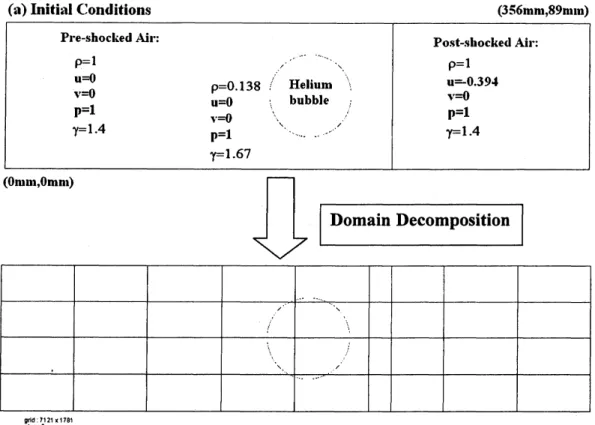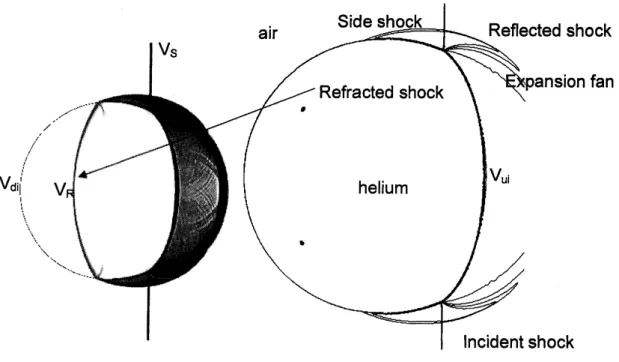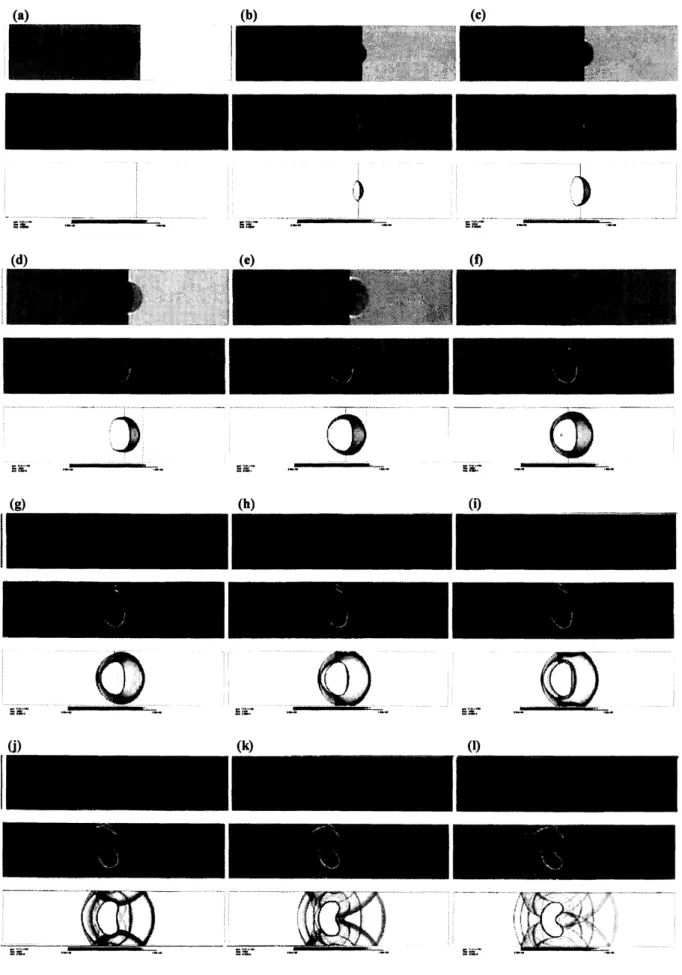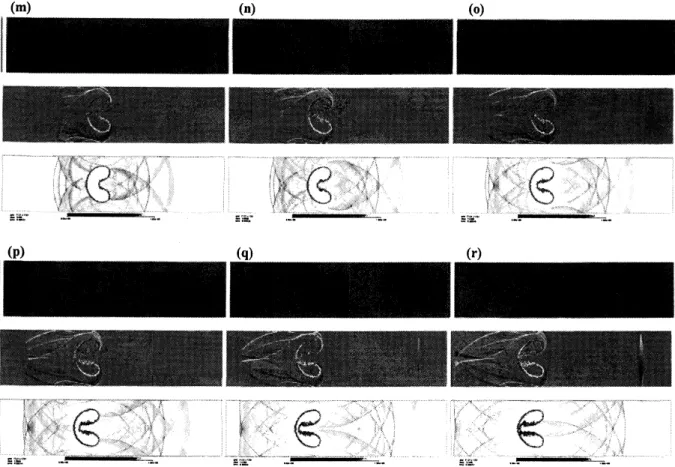PARALLEL COMPUTATION OF COMPRESSIBLE MULTI-FLUID FLOW Angel M. Bethancourt L.
Institute ofComputational Fluid Dynamics Masahiro Egami
Honda R&D, Co. Ltd.
Abstract. A collapse ofa helium bubble due to its interactions with an incoming shock
wave
is numerically examined. The flow is modeled using the two-dimensional compressible Euler equations with an additional equation of motion for the propagating interface. The solution is obtained inatwo-step manner, first, the Euler’s system ofequations is solved using Roe’s flux difference splitting scheme; second, the moving interface (affinction ofthe specific heat ratio is used to mark the fluids interface) is captured using
a
third-order WENO scheme. For both, a third-order Runge-Kutta method is used for time integration. The solver is parallelized, allowing
us
to conduct fme mesh computations, and enabling the numerical reproduction of the mechanisms observed in previous published experiments.1. Introduction
Early attempts to compute multi-fluid flow, consisted in incorporating
a
conservativeform ofthe advection equation for the material interface into the Euler system of equation [1,2,3],and solve them using standard methods developed for the classical Euler equations.
However, it
was
observed that spurious oscillations develop at the material interfaces due todifferences in fluid propertiesat the interface,
as
wellas,errors
in the locationofthe interface. In orderto solvesome
ofthe problems,a
quasi-conservative is proposed in [1], in which the advection equation is decoupled $\theta om$ the Euler equations and written in non-conservativeform.
Additional modifications to the goveming equations are made in [4,5], which render the algorithm “single-fluid” when calculating the interface fluxes at the expense of conservation, to improve the coupling of the advection-Euler equations and to account for
pressure
equilibriumacross
the interface.Inthis paper, the quasi-conservative method described in [1,4] is implemented. Because our interest is
on
high-resolution computations, this implementation is extended using MPI(Message Passing Interface) libraries for its parallelization. As application, the
interactions
2. Equationsofmotion
For the problem at hand,
we
limitour
analysis to two immiscible ideal gases, $p=(\gamma-1)p$ , characterized by their constant ratio of specific heats, $\gamma$.
Thetwo-dimensional Euler equations for such multi-component flowin conservative form
are
$\frac{\partial Q}{\partial t}+\frac{\partial E}{\ }+ \frac{\partial F}{\partial y}=0$, (1)
$Q=\{\begin{array}{l}\rho\rho u\rho ve\end{array}\};E=\{\begin{array}{l}\rho upu^{2}+p\rho uv(e+p)u\end{array}\};F=\{\begin{array}{l}\rho v\rho uv\rho v^{2}+p(e+p)v\end{array}\}$
where $p$ isthe density, $u$ and $v$
are
thevelocity components,$p$ isthepressure, and$e$ is the totalenergy ofthe fluid.
The moving interface is captured usingthe discontinuity in the ratio of the specific heats for the different components. Since material interfaces
are
advected by the flow, any hnctionof $\gamma$ obeys the advectionequation [1],$\frac{\partial f(\gamma)}{\partial t}+u\frac{\partial f(\gamma)}{\ }+v \frac{\partial f(\gamma)}{\Phi}=0$,
.
$\cdot$
.
$f( \gamma)=\frac{1}{\gamma-1}$ (2)
Spatial discretization of (1) is done using Roe’s flux difference splitting scheme. The numerical fluxis givenby:
$E_{i+1/2}=E(Q_{L},Q_{R})= \frac{1}{2}[E(Q_{L})+E(Q_{R})]-\frac{1}{2}|A|[Q_{R}-Q_{L}]$, where$A= \frac{\partial E}{\partial Q}$ (3)
$A$ isthe Jacobian matrixbased
on
Roe’s average of$Q_{L}$ and $Q_{R}$.
The modification introducedin [4] consists in calculating two fluxes at the cell interface, by “freezing” the values of$\gamma$ in
either side ofthe interface:
$E_{i+1/2}^{L}=E(Q_{L},Q_{R};\gamma_{L})$
$E_{i+1/2}^{R}=E(Q_{L},Q_{R};\gamma_{R})$
Then,
use
$E_{i+1/2}^{L}$to update the flux in cell $i$and $E_{i+1/2}^{R}$to update the flux incell $i+l$.
The spatial discretization of(2) is carried out using
a
third-order WENO scheme [6]. A TVDthird order Runge-Kutta method is used to solve both the Euler and advectionequations[6]. The equations
are
written as, $Q_{t}=L(u)$, where $L(u)$ is the discretization of the spatial$Q^{(1)}=Q^{n}+\Delta tL(Q^{n})$
$Q^{(2)}= \frac{3}{4}Q^{n}+\frac{1}{4}Q^{(1)}+\frac{1}{4}\Delta tL(Q^{(1)})$
$Q^{n+1}= \frac{1}{3}Q^{n}+\frac{2}{3}Q^{(2)}+\frac{2}{3}\Delta tL(Q^{(2)})$
(4)
The parallelization of the code is achieved by using Domain Decomposition in conjunction with a SPMD(Single Program Multiple Data)technique. The MPI libraries
are
usedto communicate betweenthe differentprocessors. Our system consists of 8 nodes, each nodecontains of$2cpu$-IntelXeon (8 cores). Themaximum number ofcores available is 64. 3. Problem Definition
Our focusis
on
the dynamics ofthe interaction ofa Mach 1.22 shockanda
heliumbubble,as
presented in [7,8]. The initial conditions for this problemare
given in Fig. 1, the upper and lower boundariesare
considered solid walls, the inflow is $fi\cdot om$ the right and propertiesare
specified, at outflow (left)a zero
gradient is imposed. A uniform grid with spatial resolution of 0.05mm
is used for the present computation, resulting in a grid size of 712lxl781. It takes approximately $12 hr30\min$ to obtain a 528 ps sample (time step:$3.3333x10^{-8}s)$using 32 processors.
4. Computational Results
Figure 2 shows a sequence of idealized Schlieren images [8], showing the overall
wave
stmcture. At 24 ps, Figure $2a$ shows
a
reffacted shock inside ofthe bubble, moving fasterthan incident shock, since thehelium has ahigher sound speedthan the air. Upstream ofthe bubble, areflected
wave
is shown moving away $\theta om$the bubble. At36 ps, Figure $2b$showsa
four-shockconfigurationwhich it isusuallytermedtwinregular reflection-reffaction(TRR),also shown in Figure 3. At 48 ps, Figure $2c$ shows the
re
$\theta acted$wave
emerging $\theta om$ thebubble and becoming the transmitted wave, also two cusps appear in the left-side of the bubble indicating intemally reflected
waves
that converge toward the axis of the bubble(Figure $2d,$ $56$ ps). At 64 ps, Figure $2e$ shows the intemal reflected
waves
diverging aftercrossing, and the two branches ofthe transmitted shock
cross
downstream ofthebubble. At 88 ps, Figure 2fthe initial reflected shock has reflected from theupperand bottom walls. At larger times (228 ps), Figures $2g$ shows that the bubble has ffirther deformed intoa
kidneyshaped object. Finally, Figures $2h$ and $2i$ show
an
induced jet ofair
along the axis of thebubble, resulting inthedevelopment oftwo vorticalstructures.
Figure 3 shows the enlargement of the twin regular reflection-refraction (TRR) shock configuration
as
wellas
the locations used to compare the shockwaves
velocities. Table 1shows the comparison of the present computation
wave
velocities with the experiment of Hass and Sturtevant [7] and Quick and Kami [8] computation. Overall agreement isexcellent, except for the values of the reflected and upstream velocities; this disagreement is due to the existence of bubble contamination which affects the values of its physical properties.
Figure 4
uses
the density, vorticity and density gradient ffinction to visualize the flow. Clearly, the bulk of the vorticity is produced along the bubble interface [9], following the progress of the reffacted shock inside the bubble. This is consistent with thesource
term$(S \equiv\frac{\nabla p\cross\nabla p}{\rho^{2}})$appearing in vorticityequationofan inviscid fluid. Themotionproduced by
the generationofvorticityisthedriven force inducingthe jetalongtheaxis ofthebubble. 5. Conclusions
The goal of simulating high resolution compressible multi-fluid flow
was
achieved. A quasi-conservative method is successffilly implemented ina
parallelenvironment
to model the interactions betweena
helium bubble anda
shockwave.
The main features ofthe floware
captured, andcompare quite well withpreviousnumerical and experimental results. Further investigation will be aimedto consider flows withmore
stiff conditions. References[1] Abgrall R., 1996 How to Prevent Pressure Oscillations in Multicomponent Flow Calculations:A QuasiConservativeApproach,J Comp. Phys. 125, 150-160
[2] Larrouturou, B., 1991, How to Preserve the Mass Fractions Positivity when Computing Compressible Multi-ComponentFlows,J Comp. Phys. 95, 59-84
[3] Mulder, W., Osher, S., and Sethian, J.A., 1992, Computing Interffice Motion in Compressible GasDynamics,J Comp. Phys. 100,209-228
[4] Abgrall, R., and Karni, S., 2001, Computations of Compressible Multifluids, J Comp. Phys. 169, 594-623
[5] Fedkiw, R.P., Aslam, T., Berriman, B., and Osher, S., 1999, A non-oscillatory Eulerian approach to interfaces in multimaterial flows (theGhost Fluid Method),J Comp. Phys. 152, 457-492
[6] Shu, C.W., 1997, Essentially Non-Oscillatory and Weighted Essentially Non-Oscillatory Schemes for Hyperbolic ConservationLaws,ICASEReportNo. 97-65
[7] Haas, J.-F., and Sturtevant, B. 1987 Interaction ofweak shock
waves
with cylindrical and sphericalgas inhomogeneities. JFluidMech 181,41-76.[8] Quirk, J. J., and Kami, S. 1996, On the dynamics of
a
shock-bubble interactionJ Fluid Mech.4129-163.[9] Picone, J.M., and Boris, J.P., 1988, Vorticity generation by shock propagation through bubblesin
a gas,
J FluidMech. 189,23-51
(a)Initial Conditions (356mm,89mm)
$t\dot{m}\text{\’{e}} 000000\triangleleft p0\mathfrak{g}ld’ 121x179t$
(d)$56ps$ (g)$228\mu s$ (e)$64ps$ (h)$412ps$ $—–\vee\cdot\cdot.\cdot--$ (i)$464ps$ (f)$88ps$ —-$\cdots$
Figure 2. Idealized Schlieren images generated following the methodology outlined in [8]
(usingthe magnitude ofthe gradient ofthedensity). a) 24
ps,
b)36 ps, c)48 ps, d) 56ps,
e)64 ps, f) 88 ps, g) 228 ps, h) 412 ps, i) 464 ps. Times
are
estimates after the shock impact into thebubble.Figure 3. Twin regular reflection-reffaction (TRR) shock configuration as well as the locations usedto comparetheshock
waves
velocities. $V_{S}$:
velocityofincident shock. $V_{R}$:
velocity ofrefracted shock. $V_{T}$: velocity of transmitted shock. $V_{ui}$ : velocity of upstream
edge ofbubble, initial times. $V_{di}$
:
velocity of downstream edge of bubble, initial times. $V_{j}$ : velocity ofjethead.$)$
— $-$
$\S$
–
$\overline{\overline{\underline{-}}\underline{g}\cdot.--}-\overline{-}-$ $g^{\frac{1}{a^{m}\cdot-\frac{\sim}{}-}}\underline{-}i\underline{=.}-\cdots.--$
$-\overline{\ovalbox{\tt\small REJECT}}$ $\overline{\ovalbox{\tt\small REJECT}}$ $—-\overline{\ovalbox{\tt\small REJECT}}_{j}^{*}$
$\overline{\underline{-}}\underline{-\cdot\cdot}$. $\overline{-}---$ $\underline{-}-\cdot$ $-\overline{-}-$ $–\overline{g\mu\underline{\cdot}\cdot.\cdot}$
$—’-$
$\overline{\underline{\epsilon}_{\ddot{r}^{-}-}}$ $rightarrow-$ $\underline{\epsilon}:\cdot-\cdot\cdot$ $-.-$ $—-\underline{\underline{-}}ia^{\infty}-$ $’-$ $\cdot\cdot$
–
$-7...:\overline{\overline{-}}a^{m}..\cdot\cdot\wedge.-\cdot..\cdot\cdot\cdot\underline{}.\underline{-}j1^{*\cdot\cdot\cdots\cdot-\infty-},’.ae^{:}.\cdot..\cdot\cdot\cdot _{\dot{\mathfrak{t}}}\overline{-}\cdot-\overline{r-}arrow$ $|\underline{r_{\overline{\wedgearrow-\cdot-}\cdot:.-}\overline{g}}$.. $–arrow\sim-$

![Figure 2. Idealized Schlieren images generated following the methodology outlined in [8]](https://thumb-ap.123doks.com/thumbv2/123deta/5977839.1059037/6.892.137.770.129.632/figure-idealized-schlieren-images-generated-following-methodology-outlined.webp)


